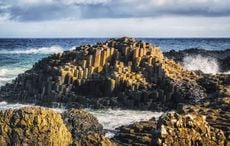Did your ancestors fight in the 1916 Rising? A group of Irish filmmakers want to hear their stories.
With the centenary of Ireland’s 1916 Easter Rising well under way, ideas about how best to commemorate and reflect upon this seminal moment in Irish history have already begun to circulate, accompanied by a great deal of debate.
For filmmakers Keith Farrell and Dave Farrell of Tile Media, the crux of commemoration is not the big heroic names that have endured through history, nor is it the question of who deserves to take part. Instead, they have chosen to focus on the stories of the regular people active in and affected by the Rising.
“There have been lots of stories told about the leaders of 1916. This is not one of them,” producer Dave Farrell says of Tile Media’s new docudrama “A Terrible Beauty.” Its name is borrowed from the W.B. Yeats’ poem “Easter 1916” – “All’s changed and changed utterly / A terrible beauty is born.”
“It’s about the ordinary soldiers on the ground, the civilians who were caught in the middle. It’s about idealism; it’s about people who were willing to risk their lives for an ideal.”
Keith Farrell, the film’s director, agrees. “Everybody knows about the big hero figures of history, but no one ever knows about the little guy in history, the ordinary fella caught in an extraordinary event.”
The 1916 Rising was indeed an extraordinary event, spanning six days from Easter Monday, April 24 to Saturday, April 29.
The leaders of the Rising – Thomas Clarke, Sean Mac Diarmada, Thomas MacDonagh, Pádraig Pearse, Eamonn Ceannt, James Connolly and Joseph Plunkett – declared Ireland’s independence from the United Kingdom with Proclamation of the Irish Republic.
Irish rebel forces over 1,200 strong, including the Irish Republican Brotherhood, the Irish Volunteers, the Irish Citizen Army and 200 women of Cumann na mBan, took over strategic locations throughout Dublin, with smaller actions in Galway, Louth, Meath and Wexford.
The British military, which had been focused on WWI, was caught by surprise initially, but by the end of the week had brought 16,000 troops to Ireland to quell the Rising, which ended on April 29 with the surrender of the provisional Irish government ordered by Pádraig Pearse. Later, 16 leaders of the Rising were executed. Fatalities from combat included 64 rebel deaths, 132 British soldiers, and over 250 civilians. There were over 2,000 total casualties.
In order to better understand the experiences of the ordinary individuals on all sides of the Rising, the “Terrible Beauty” filmmakers used firsthand accounts – letters, diary entries, testimonies, etc. - from Irish rebels, British soldiers and Dublin civilians alike.
From these descriptions, they re-created events of the six days of the Rising but also allowed the actors portraying these individuals to speak directly to the camera, documentary-style, sharing their experiences. Interspersed between the scenes of action and these quieter monologs are insights from historians and 1916 experts.
The cumulative effect is astonishingly moving and comprehensive, and screenings of the film in Ireland, the UK, and the US have received overwhelmingly positive feedback – most recently a rave review in the Chicago Tribune.
These reactions, and the feedback from descendants of the people whose stories feature in “A Terrible Beauty,” quickly led the filmmakers to see that the 1916 Rising was rife with many more such stories just waiting to be told.
Inspired by this, they are embarking on what they call a “living history” project – gathering the stories of the participants and living relatives of those involved in the Rising in one place, where they can be chronicled and shared.
In addition to this online portal, they will also make short documentaries about each story, featuring recollections, historical documents, and interviews with relatives.
The first such living history centers on a man named Tom Byrne who went on to become the first Captain of the Guard at Leinster House (Irish Parliament), and his wife, Lucy Agnes Smyth, a Section Leader in Cumann na mBan, both of whom were in the General Post Office (used as the rebels’ HQ) during the 1916 Easter Rising.
Their daughter, Sheila O’Leary, now 92, is likely the only living offspring of two people who were in the GPO during the rising. Furthermore, her godmother was Jenny Wyse Power, one of the founding members of Cumann na mBan and its first president.
Sheila and two other generations of the Byrne family shared their mementos, memories and stories for the first living history documentary, a preview of which has just become available:
'Byrne Family' Promo from Tile Media on Vimeo.
The stories of Tom and Lucy are remarkable, and it’s thrilling to know that there are many more such stories out there just waiting to be told. Tom, a brave adventurer from early on, journeyed to South Africa in 1896 at the age of 19 to find work in the mines. When the Boer War broke out, he helped form the Irish Brigade there to fight against the British, serving for three years from 1889 – 1902 before surrendering and being taken on board a Portuguese prison ship, which eventually set him free at Ellis Island in New York. He spent 11 years working in mines in the Western US before returning to Ireland where he joined the Irish Volunteer movement – B Company, 1st Battalion.
In the Rising, he was one of the “Maynooth 15,” who marched from Kildare to the GPO. It was there that he first met Lucy Agnes Smyth, on first aid detail, who brought him a basin of water to bathe his feet.
During the Rising, she smuggled arms from a house before it was raided, delivered messages around Dublin and tended to the wounded. After the surrender, she helped escort casualties from the GPO to Jervis Street Hospital.
Tom led his men to successfully prevent the British from taking over the Mail Office. Later, in the GPO, he kept the volunteers defending the barricades awake through three nights, not sleeping himself. Tom and his men then took up post at the one house on Liffey Street still in Irish control. On Friday, when it became clear the fight was coming to an end, he gave them all a chance to get away and fled in disguise to Belfast, where he hid for six months. After returning to Dublin, he was appointed Commandant of the 1st Battalion.
He and Lucy Agnes Smyth were married on April 28, 1919. In 1920, British soldiers broke into their house in the middle of the night and arrested Tom. He was imprisoned in England for a few months, released back to Ireland, and then arrested again later that year at Rath Camp in the Curragh. In 1921 he was one of close to 50 prisoners who escaped through a tunnel they had dug.
In 1922, Michael Collins put Tom forward for the position of Captain of the Guard at Leinster House (the Irish parliament). The Byrne family later moved to the Gatekeeper's House at Áras an Uachtaráin in Phoenix Park, where Sheila and her siblings would often see Douglas Hyde (who was the first President of Ireland under the 1937 Constitution) and many Irish and foreign visiting dignitaries.
In 1946, the South African government awarded him a medal for his efforts in the Boer War, which was presented to him by Eamon de Valera. He retired in 1947.
In April, Sheila was invited by the Department of Defence to attend the centenary celebrations of the founding of Cumann na mBan at Glasnevin Cemetary. She said that she was delighted to be able to honor her mother's involvement in the movement and says that she never felt so proud in her life as on that day, not for herself but for the women of Ireland.
Does your family have an Easter Rising story to tell? Contact Dave Farrell – Producer - dave@tilemedia.ie or Colin Farrell – Project Manager - colin@tilemedia.ie, or visit the website. They can also be reached on Twitter @1916film or on Facebook.
*Originally published in October 2014.




Comments